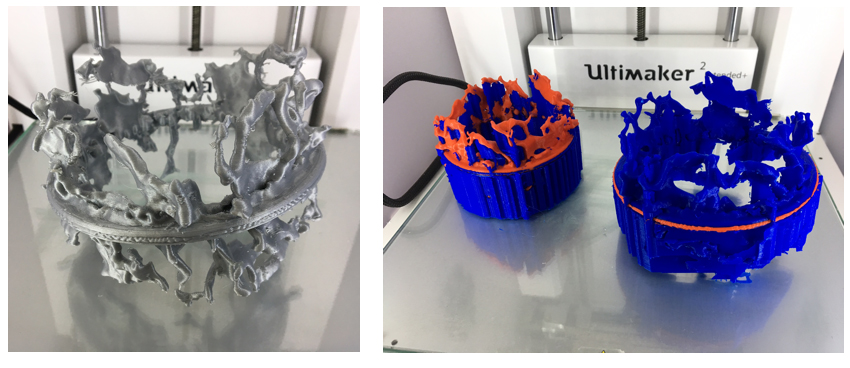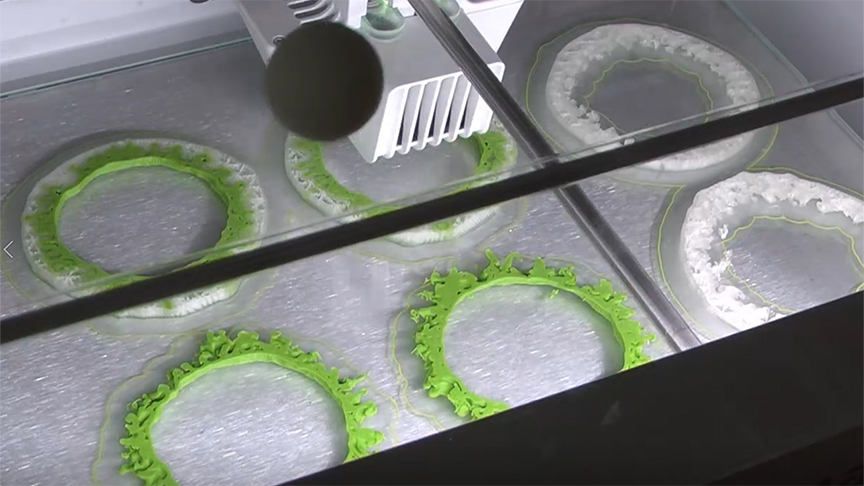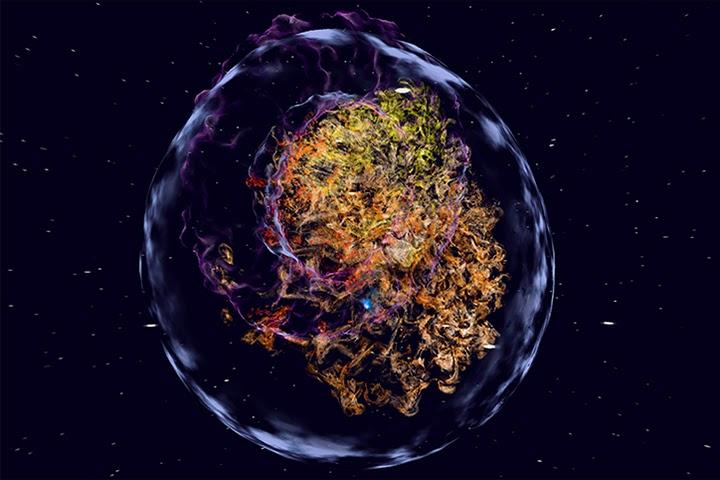For two decades, the orbiting Chandra X-ray Observatory has captured the hot, turbulent regions of space, like exploded stars, clusters of galaxies, and matter around black holes. It has helped scientists see the “invisible” wavelengths of objects in space and answer fundamental questions about the universe. To a flagship space telescope like NASA’s Chandra, the universe is completely different. With an eye that can reach as far as quasars at the edge of the observable universe (that’s 46.1 billion light-years away), it has captured more than 16,500 observations. Now, a collection of nine 3D objects from Chandra are available on a new platform from the Smithsonian Institution.

3D prints showing the SN 1987A supernova remnant using the Ultimaker 3 printer. Image courtesy of Salvatore Orlando from the INAF Observatory/NASA.
Through various techniques, astronomers have captured data from Chandra and other telescopes and constructed science-based simulations and 3D models of what previously had been represented as flat, two-dimensional projections on the sky. Anyone can watch the 3D models on the online Voyager platform, manipulate them, view them in augmented reality and download the 3D print-ready files. Most 3D printable models and information on how to print them are also available through the Harvard-Smithsonian Astrophysical Observatory’s dedicated site. Together, the online resources host an impressive dataset of some of Chandra’s most significant discoveries.
From nebulas to supernovas, the current suite of Chandra 3D models and 3D printable files features stars in various phases of the stellar life cycle. Engaging users, the sites describe each 3D modeled object as a unique experience to understand scientific data. For example, users can go from watching the remnants of the dead star Cassiopeia A up close to holding it in their hands after printing the model.

Stereolithography (STL) files were used for 3D printing Tycho’s Supernova Remnant. Image courtesy of NASA/CXC/SAO/A. Jubett, N. Wolk and K. Arcand.
Anyone with access to a 3D printer can also choose to print the blast wave of two novas, U Scorpii and the double star system V745 Sco. Astronomers have seen U Scorpii – which is about 40,000 light-years away from us- erupt about once every decade, so this system is due for another outburst very soon, which should make for a super interesting printable structure.
As for V745 Sco, located about 25,000 light-years from Earth, Chandra X-ray Observatory captured the system’s last eruption on February 6, 2014. The new 3D model of the explosion shows details of the blast wave, the mass ejected by the explosion, and the disk of cooler material, which is mostly untouched by the effects of the blast wave. For each of these 3D models and 3D printable stories revealed through Chandra’s vast dataset, users learn to experience events in an entirely new way, making this quite a unique experience, especially for institutions such as libraries and museums, as well as the scientific and education communities.

The 3D model serves as a scientifically informed approximation for visualizing the Crab Nebula in X-ray light. Image courtesy of NASA/CXC/SAO/A.Jubett.
Another fascinating 3D model and printable option available through Voyager is the Crab Nebula, which contains the remains of an exploded star located about 6,500 light-years from Earth. In this case, the structures revealed by Chandra’s X-rays include the pulsar and a ringed disk of energized material, with jets of particles that fire off from opposite ends of the energetic pulsar. The 3D structures serve as scientifically informed approximations for visualizing the nebula. Holding a printout of a star formation is also possible. About 450 light-years away, DG Tau made its stellar debut as a 3D model and printable file on both sites.

3D Model of supernova remnant IC 443 for Virtual Reality. Image courtesy of NASA/CXC/Brown University/A. Dupuis.
The inclusion of the Chandra collection in Voyager also coincides with the release of Chandra’s latest 3D model, a stunning supernova remnant called IC 443 located about 5,000 light-years from Earth. Details of the model are included in a paper published in the journal Astronomy & Astrophysics by researchers from the National Institute for Astrophysics (INAF) in Palermo, Italy. In a version for Voyager, the 3D model has been transformed to be more suitable for augmented reality and 3D printing, which requires connected structures.
Developed by the Smithsonian Digitization Program Office, the Voyager platform enables datasets to be used as tools for learning and discovery. Viewers can explore these fascinating 3D representations of objects in space alongside other historical renderings, like a statue of George Washington or a skeleton of an extinct mammoth. There are also additional levels of information and interaction for the Chandra 3D models, including annotated tours pointing out key features on each cosmic object.
While unable to fly to such a distant object and zoom around it, astronomers can use Chandra’s data to learn about the geometry, velocity, and other physical properties of the cosmic sources. The experience will engage cosmic fans worldwide. To 3D print the datasets, users can easily download the 3D files from either of the two sites. A full list of the Chandra 3D objects, along with information about how to view and print them, is also available here.
Subscribe to Our Email Newsletter
Stay up-to-date on all the latest news from the 3D printing industry and receive information and offers from third party vendors.
You May Also Like
World’s Largest Polymer 3D Printer Unveiled by UMaine: Houses, Tools, Boats to Come
The University of Maine has once again broken its own record by unveiling the largest polymer 3D printer in the world. Surpassing its 2019 achievement, the new Factory of the...
Changing the Landscape: 1Print Co-Founder Adam Friedman on His Unique Approach to 3D Printed Construction
Additive construction (AC) is much more versatile than it seems, at first: as natural as it is to focus on the exciting prospect of automated home construction, there’s far more...
Gorilla Sports GE’s First 3D Printed Titanium Cast
How do you help a gorilla with a broken arm? Sounds like the start of a bad joke a zookeeper might tell, but it’s an actual dilemma recently faced by...
3D Printing Webinar and Event Roundup: April 21, 2024
It’s another busy week of webinars and events, starting with Hannover Messe in Germany and continuing with Metalcasting Congress, Chinaplas, TechBlick’s Innovation Festival, and more. Stratasys continues its advanced training...





























